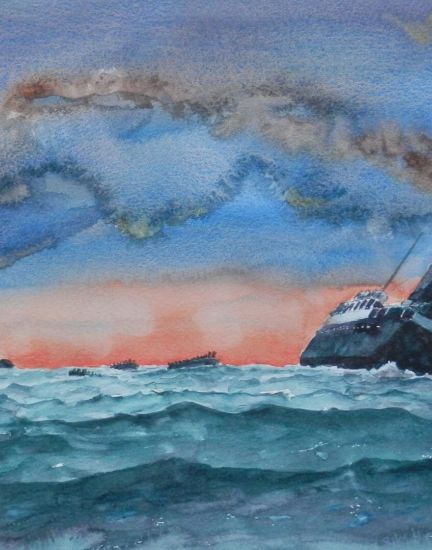
The sea and coastline of The Catlins were very important to Maori and later to the early European settlers who gradually developed small townships along the coast. Because the hinterland was heavily timbered, access was by sea. Coastal traders played an important part in the lives of these people. However, the coastline was not always kind. Gales blew up from the south and south-west, the sea became wild and wicked, and many mishaps occurred amongst the sailing vessels (top-sail or fore-and-aft schooners, or ketches) and small steamers (more commonly seen in the 1880s and later).
The "SS Tararua"
The Catlins’ major shipwreck was the “SS Tararua”. The Tararua was a screw steamer with sails. It was owned by the Union Steamship Company and built by Gourley Brothers of Dundee, Scotland, having a gross weight of 827 tons.
The “Tararua” struck the reef at Waipapa Point on 29th April, 1881 and was wrecked to pieces in a heavy swell. Although a passenger did manage to swim ashore, help was still a long way off. A young workman from a nearby station rode to Wyndham, many miles away, with the message about the sinking but it was already too late. Passengers and crew were swept off the deck by the waves. The death toll of 131 passengers and crew (from 151 on board) still stands as New Zealand’s worst maritime disaster involving civilians. Captain Francis Garrard was also drowned.
The tragedy brought the call for a lighthouse at Waipapa Point. Waipapa had earlier claimed a wreck when in 1876 the “William Ackers” hit the reef and became a total wreck with the loss of 8 lives. Three years after the “Tararua” disaster the lighthouse was built. The first light shone out on January 1884.
Nugget Point (Ka Tokata) in North Catlins also has a lighthouse which stands 76 metres above sea level and was built of locally quarried stone in 1869-70. It is now fully automatic and is one of the Catlins’ best-known coastal landmarks.
A large number of small trading vessels plied the coast between Dunedin and Invercargill taking away timber and wool and bringing in stores for the settlers. Many got into difficulties in heavy seas or sometimes crossing the bars. Other shipwrecks of importance were the immigrant ship “Surat” (1874), The “Otago” (1876), and the “Manuka” ( 1929) – all without loss of life. A recent revelation is the “Burmah” (c1859-60), a total loss near Tautuku with 50 people on board.
The Manuka
The Union Steamship Company’s twin screw steamer, the Manuka, was wrecked at Long Point (Irihuka) on December 16th, 1929 after hitting a reef. There were approximately 283 passengers and crew on board. Captain Clark and crew ensured that passengers boarded lifeboats and there was no loss of life from the sinking. Passengers were transported to Owaka and hosted by local residents until they could continue on to Dunedin by train. The Manuka was built by William Denny and Brothers, Dumbarton, Scotland in 1903 and weighed 4534 tons. Articles salvaged from the wreck can be seen at the Owaka Museum.
The Surat
On the 1st of January, 1874 the immigrant sailing ship, the Surat, foundered and later sank near the mouth of The Catlins River at Forsyth’s Beach (later Surat Bay). With Captain Johnson at the helm the Surat struck a reef at Chasland’s Mistake and began to take on water. One hundred passengers were offloaded at Jack’s Bay and the captain sailed northwards, but the ship was beached and consequently wrecked when it reached its final resting place. There was no loss of life but the immigrants lost most of their personal possessions. The Surat was a 3-masted sailing ship weighing 1,000 tons.
The Otago
The steamship, the Otago, (which was rigged as a barque) was wrecked at the northern end of Chasland’s Mistake (Makati) on December 4th, 1876.The Otago was built by James Lawrie and Company at Whiteinch on the Clyde River, Scotland, and launched in 1863 as a mail ship. It had a gross tonnage of 750 tons. Under Captain George Calder’s leadership it was to have travelled from Port Chalmers to Melbourne via Bluff and Hobart. It had a crew of 40 and approximately 80 passengers. The passengers and crew came ashore in four lifeboats and landed on Waipati Beach. They all survived the catastrophe.
In spite of these many near and sometimes total disasters, shipping continued to be the main means of transport right up until the late 1800s when railway development arrived and brought the beginning of another era.